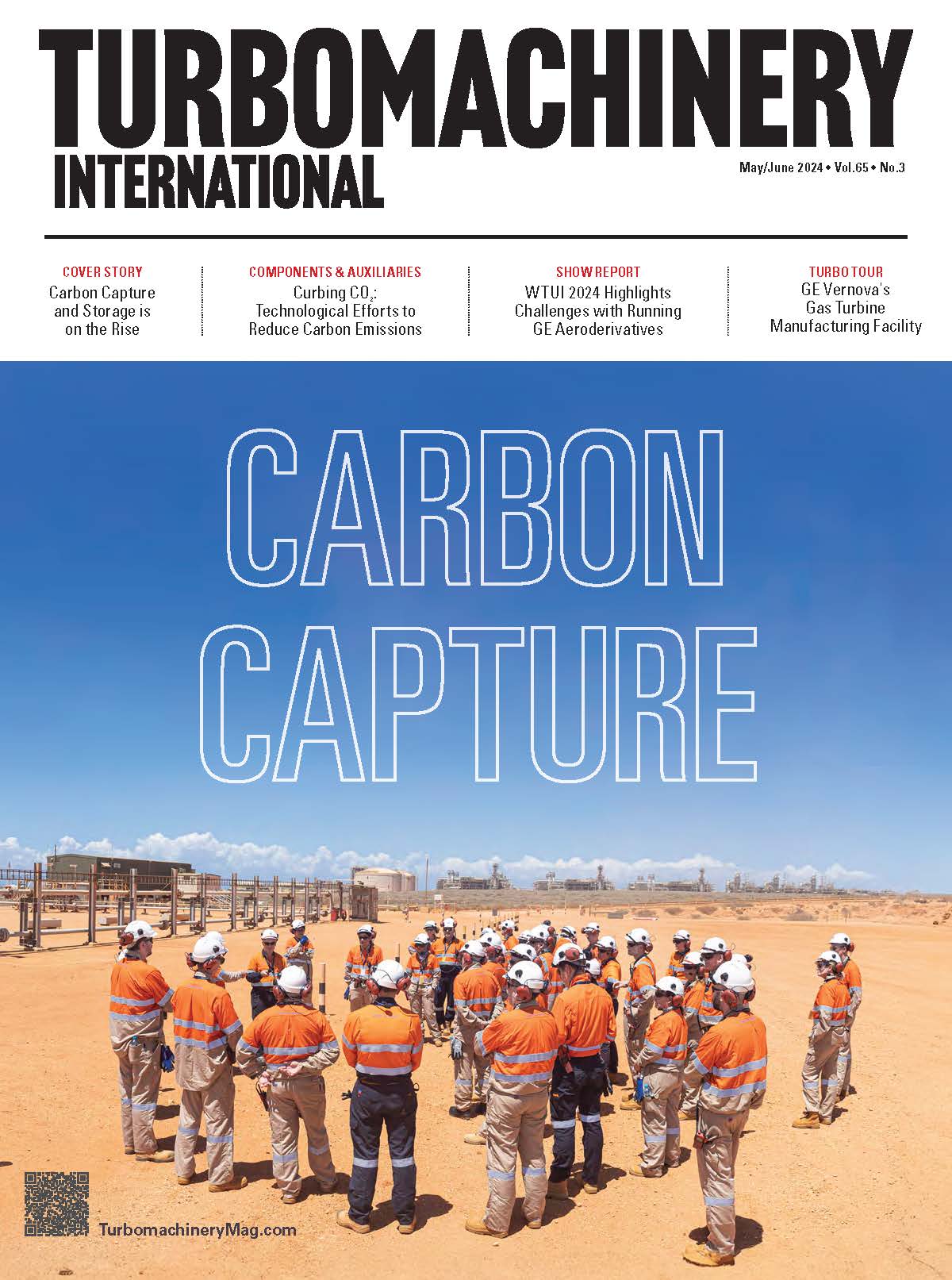Turbo Tour: GE Vernovaʼs Gas Turbine Manufacturing Facility
GE Vernova’s center in Greenville, SC operates as a validation testing facility, technology laboratory, and repair shop for the company’s gas turbine portfolio.
Greenville, South Carolina, rooted in the manufacturing industry and home to approximately 60,500 manufacturing employees across numerous companies, is the headquarters of GE Vernova’s Gas Turbine Manufacturing and Technology Center. Built on 413 acres of land with over 1.7 million square feet of manufacturing space and laboratories, the facility has been a gas turbine manufacturing plant since 1968. Currently, the grounds contain a gas turbine technology center, a repair center, combustion manufacturing, an outage simulator, a variety of test stands, and the gas turbine technology, combustion, and static load labs.
In early spring 2024, Turbomachinery International toured GE Vernova’s facility, which employs thousands of local residents, contributing to the region’s long-standing history of manufacturing.
THE SHOP FLOOR
The tour began on the manufacturing shop floor with Ed Stefanik, Greenville Plant Manager, leading the charge. Originally established as a gas turbine manufacturing facility and later expanded, this segment of the campus is operated according to GE Vernova’s “lean” manufacturing principles.
The goal of lean is to eliminate waste across the board: eliminating redundant work, tracking goals in a centralized meeting space, reducing the physical footprint of each machine, and more. This lean idea even extends to reducing the distance that a part may travel while on the shop floor: The company reduced the average distance of buckets traveled from 3.1 miles to just over 300 feet.
The fourth gas turbine assembly bay, cleverly dubbed “D Bay,” gave insight into the assembly process and sheer number of machines that flow through the area. According to Stefanik, GE Vernova shipped out 3,300 gas turbines from Greenville since the start of operations, all of which came through D Bay.
GE Vernova’s 9F.05 gas turbine assembly area. Credit: GE Vernova
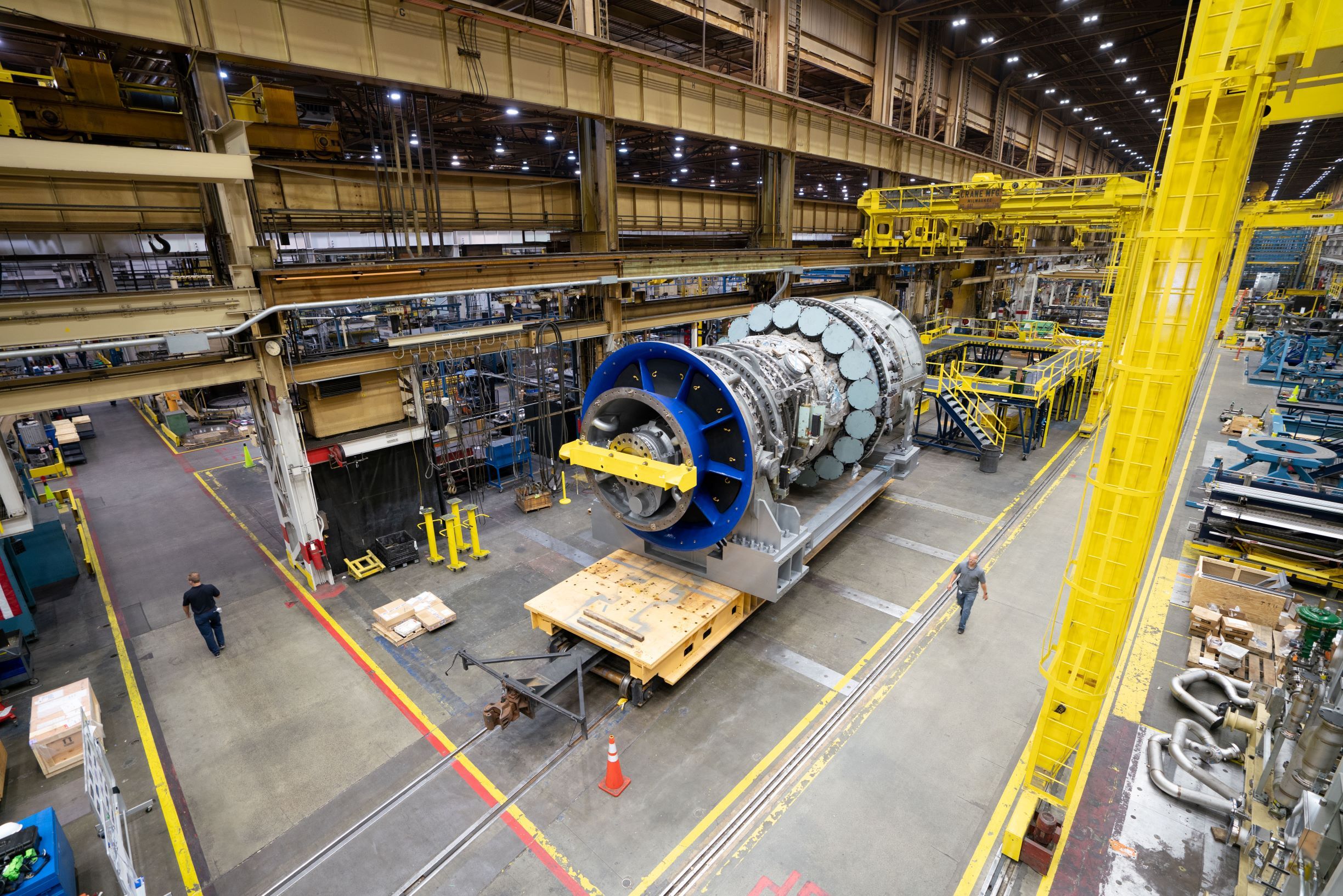
Turbine casings are lifted on vertical assembly stands in D Bay for drilling, alignment, and bolting processes that take approximately five days. In the next step, “The [assembled casing] is laid down horizontally. It then goes into one of these build stands, we take off the upper half casings, and then we load all the internal components including the rotor,” said Stefanik. “That process takes between seven and 14 days.”
The manufacturing space also conducts maintenance, repairs, and overhaul work on turbines that have met their maximum operating hours in the field. Many of the models in this area have been operating since the late 1990s and early 2000s.
“Our engineering team brings the older turbines in to do a full inspection, make some repairs, and replace components, and can re-certify them for approximately 80,000 hours of extended life,” said Stefanik. “A lot of the upgrades and expansions in the next steps of our lean journey are heavily focused on rotor repair.”
Cody Ford gets a bird’s eye view of Test Stand 7. Credit: GE Vernova
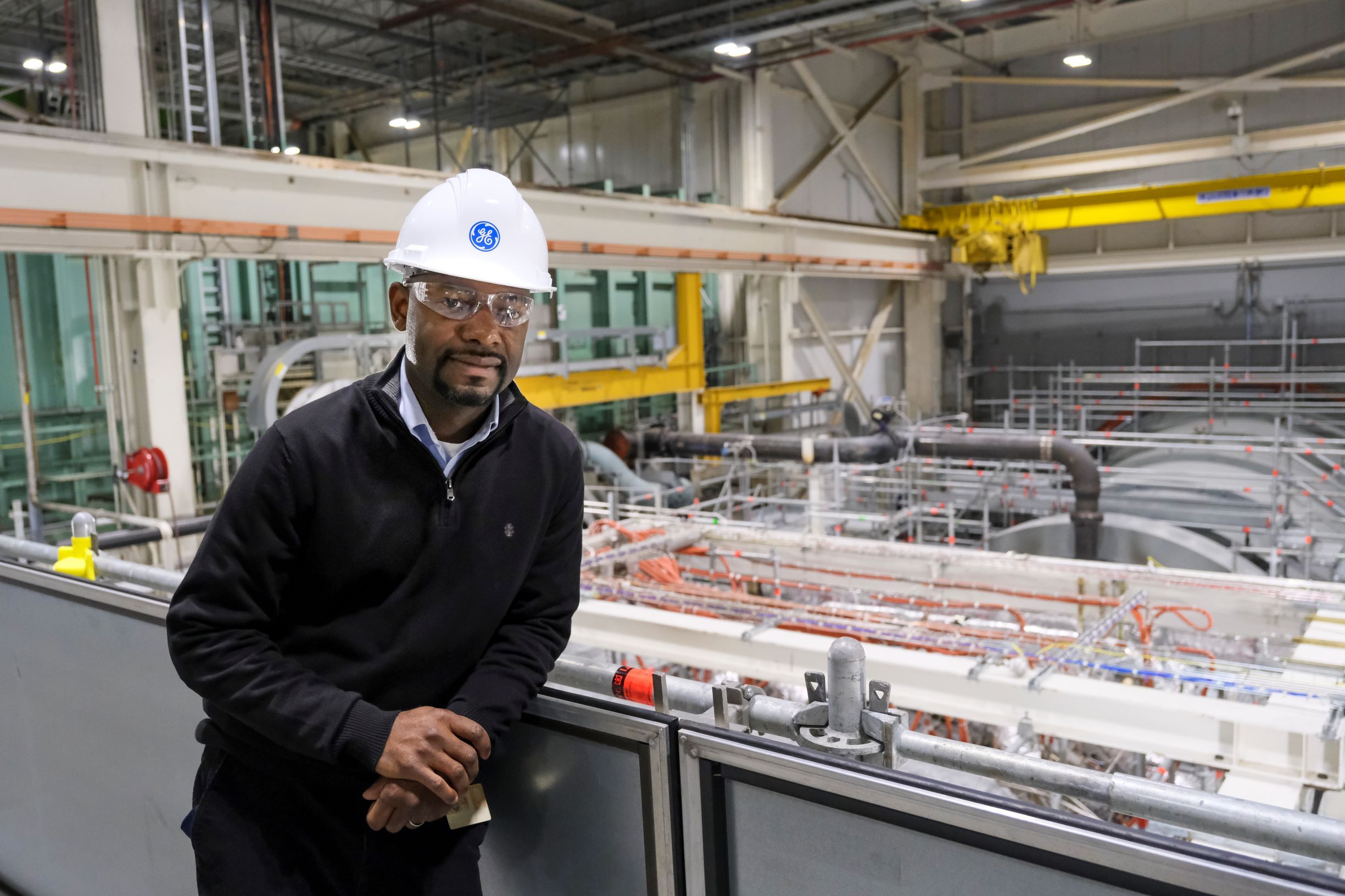
TEST STAND 7
Our team’s next stop was Test Stand 7. It contains six critical components: a starter motor, drive motor, torque converter, gearbox, load compressor, and the gas turbine being tested.
“It’s a 50-meter drive train—we start with an 88SM motor for initial acceleration and a drive motor for acceleration to full speed. Then a torque converter and gearbox allow both 50 Hz and 60 Hz operation,” explained Cody Ford, Senior Engineering Manager. “We use a load compressor to simulate being on the grid.”
Air is fed into the test rig via large ducts that span the ceiling and connect to the drive train’s compressor section. Throttling valves help transport the load through a shaft to the gas turbine. The model currently hooked up is the company’s advanced 7HA.03 gas turbine—one of the many since 2011 to come through the facility for full-speed, full-load validation.
The entire testing process typically takes several months before shipping out via rail, and the facility can test either natural gas or liquid fuel based on a customer’s needs.
Outside of Test Stand 7. Credit: Turbomachinery International
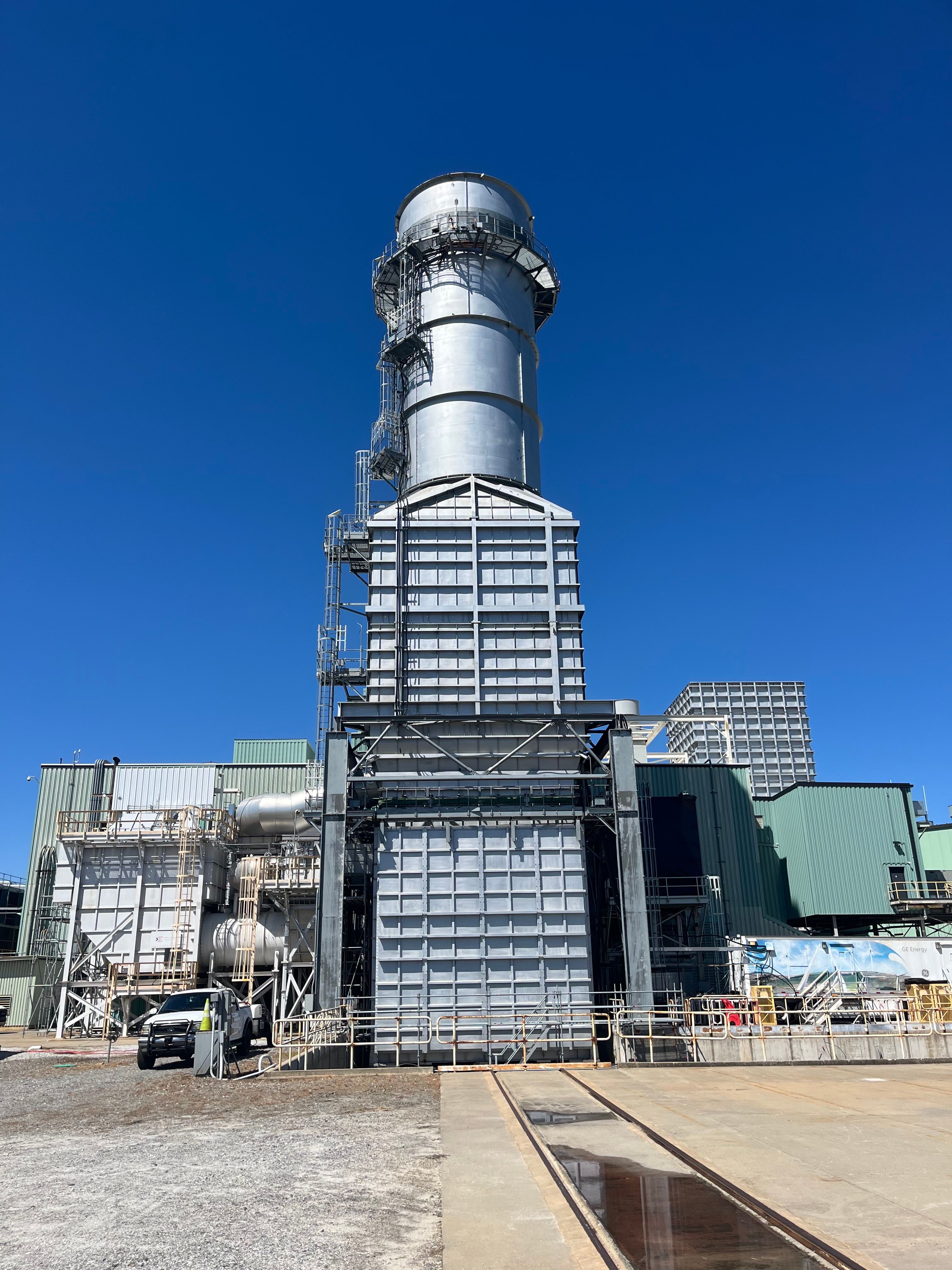
GAS TURBINE OUTAGE SIMULATOR
We discovered on our walkthrough of the outage simulator—hosted by Karen Maud, Senior Engineering Manager; Tom Mogle, Technical Leader; and Dave Runkel, Lead Tooling Engineer—that the facility is home to a space for GE Vernova’s engineers to brainstorm and develop tools to make the millwrights’ work more efficient and pain-free. Parts and tools are 3D-printed to prototype their use in the field before final development and implementation.
Runkel highlighted a recent tooling development that helped millwrights access the lower section of the gas turbine, reducing physical exertion and assisting in nozzle extraction and component installation. “We came up with a temporary gantry crane that we mount to the horizontal joint that goes down [to the lower half of the turbine]. We also designed additional tooling that allows us to attach components to the lower half and pull those components without needing to send someone down there—that saves a lot of time and is much safer for our teams.”
During the Live Outage tour, Jeremiah Smedra of Value Stream Programs explained that the field procedure documents started as an onsite paper-based program and developed into a fully integrated, digital information and reporting system. Multiple routers provide Wi-Fi and site data directly to devices, such as tablets and large screen monitors, for a field procedure app used by the onsite team. The app offers a centralized hub with access to work tasks, technical documents, lists of parts, images, and demonstration videos.
“Historically, the shift turnover notes were done in Word documents by the field engineers. Now, we can start to aggregate what was done from the tablets and auto-populate lists,” said Smedra. “Then, when the field engineers put their open items in, we can aggregate those at a regional level. Our ability to see things, understand things, and bring resources to bear—that’s a game changer.”
A One Field Services employee demonstrates field technologies in the gas turbine outage simulator. Credit: GE Vernova
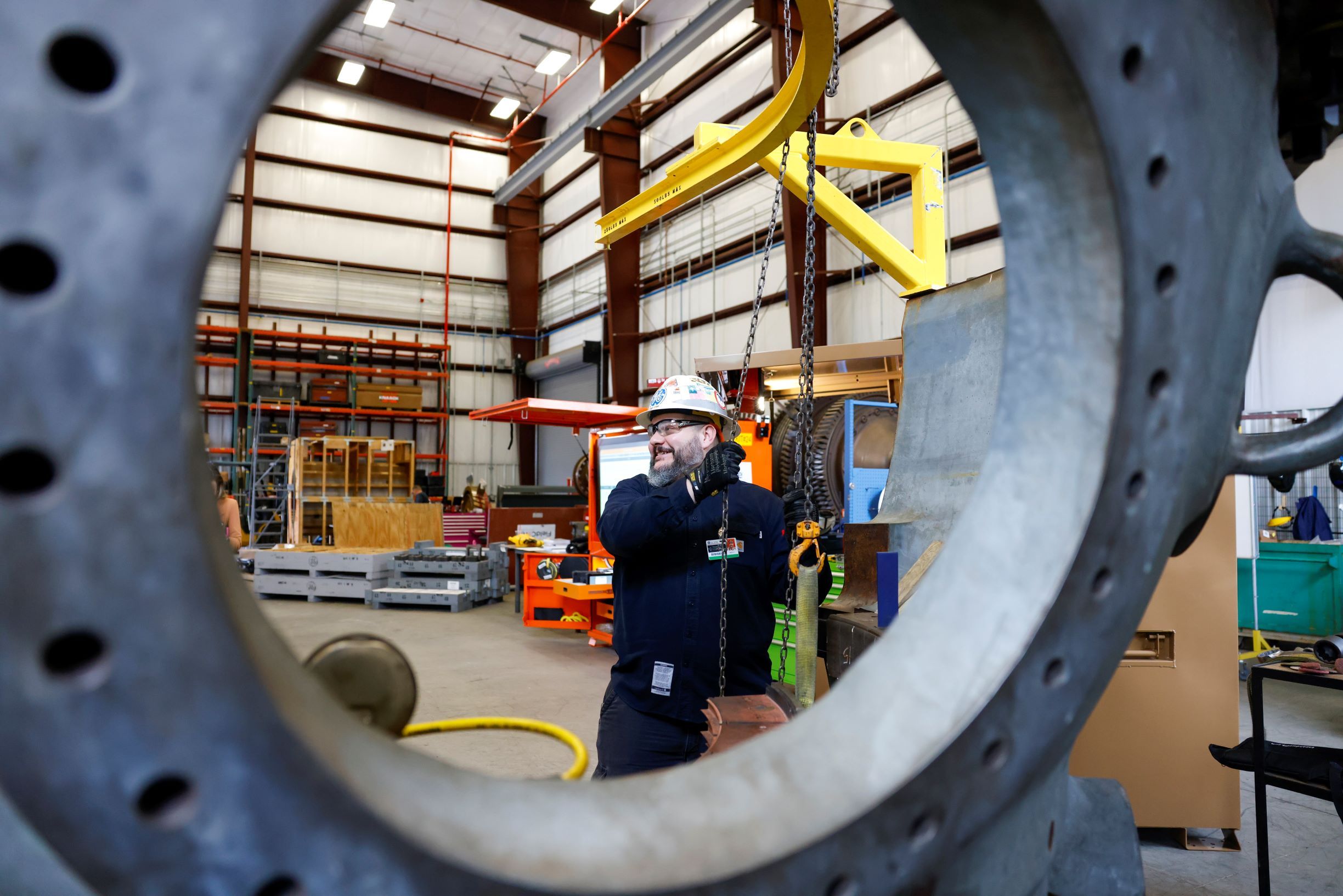
THE TESTING LABORATORIES
Combustion testing is a vital aspect of GE Vernova’s services in Greenville, using a variety of fuels and operating conditions to allow experts to assess the performance of a gas turbine in real-time. Diana Setzer, Senior Engineering Manager; Will Moore, Technical Leader in Testing; Will York, Technical Leader in Combustion Design; and Fabien Codron, Senior Product Manager, guided the tour through its Combustion Lab Control Center and Testing Lab. The control center is manned by the engineering team and the data recording team, examining live video images of the combustor during full-speed, full-load tests.
The lab conducts early developmental testing with renewable fuels, such as hydrogen, to assess combustion performance, component durability, and levels of emissions within GE Vernova’s emerging technologies. Dry low NOx (DLN) technology is currently a heavy focus of the combustion lab.
“GE Vernova is testing DLN technology, which employs lean pre-mix combustion,” said York. “The reason we use lean pre-mix combustion is if we pre-mix the fuel and air well, then we can have lower emissions than our diffusion flame combustors. Instead of maybe 200 - 300 parts per million of NOx, we’re able to get some of our F-class combus-tion systems down to single digits.”
The testing lab displayed a variety of parts for one of GE Vernova’s combustors, and York explained how the company’s developed technology can work with hydrogen-natural gas blends while avoiding roadblocks presented by hydrogen’s inherent characteristics. Controlling the hydrogen flame and flashback requires special consideration with a DLN system.
“We designed our micro-mixer fuel nozzle, which consists of a bunch of small tubes that air flows through, into which fuel is injected. These are made with additive manufacturing and produce small jet flames,” said York. “The advantage now is that the flow goes straight through and it’s aerodynamically clean—you use turbulent diffusion and jet in crossflow mixing and get compact flames. This runs much better on hydrogen without flashback than earlier DLN systems.”
The micro-mixer technology was tested to run up to 100% hydrogen at the lab but was later retrofitted to include the use of natural gas to create the DLN2.6e combustor, which can burn on blends of natural gas and up to 50% hydrogen. According to York, many operators want the ability to switch between fuels based on available supply and a variety of operational factors.
WHAT’S NEXT?
GE Vernova spun off from GE as a standalone entity on April 2, 2024. It will now comprise three operating segments—power, wind, and electrification—and is supported by its accelerator businesses. The company continues to focus on providing a multitude of power solutions for its worldwide customer base to help them power economies and deliver electricity. The standalone will continue to conduct research and product development with emerging fuels and technologies, all the while working in tandem with federal regulations to ensure a cleaner future.
Innovations such as advanced manufacturing techniques, combustion testing with renewable fuels, and large-scale project data aggregation are tools GE Vernova is using to achieve its overarching goals. A lean approach is ingrained within every facility, process, and piece of machinery put out by GE Vernova, eliminating waste to accelerate the company’s future growth.
“In Japanese, ‘kaizen’ means continuous improvement,” said Chris White, Communications Leader, GE Vernova’s Gas Power Business. “When you come in as a cross-functional team on a Monday, you leave on Friday with a different process. That’s how we accelerate GE Vernova’s growth and improvement. Kaizen is a key part of the lean methodology and central to who we are as a company.”
Visit turbomachinerymag.com/videos for video coverage from our onsite tour.
